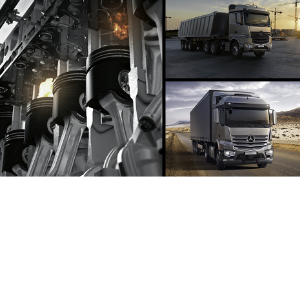
Ultra Low Sulfur Diesel
Mercedes-Benz diesel engines meet the highest standards in terms of performance, reliability and environmental compatibility.
To ensure these, compliance with the national emission standards when operating the engines is a top priority. For this reason, Mercedes-Benz designs its diesel engines pursuant to the European Standard (EN) 590. This fuel standard, which has been mandatory in the EU since 1 January 2009, defines a maximum limit of 10 mg/kg sulfur in diesel fuel. However, the fuel quality as per EN 590 is not available all over the world. A higher sulfur content can significantly impair the performance of Euro V and Euro VI engines. The sulfur contents of common diesel fuels worldwide are classified in the table below for the particular countries.
If you operate your vehicle in countries outside the EU with an
elevated sulfur content, we kindly ask you to carefully read
and
observe the information below:
Please note! Mercedes-Benz diesel engines are designed for diesel fuels pursuant to EN 590. Other types of fuel may irreversibly damage the engine and the emission control system, and significantly shorten their expected service life. Our urgent recommendation therefore is to fill up with low-sulphur fuel! Should you be unable to find low-sulphur fuel, we offer you the technical Sulfur Robustness Packages below. Please note that compliance with the specifically applicable national emissions standards is mandatory during vehicle operation, even after the conversion.
When this Specification for Operating Fluids was drawn up, we were aware of the following sulfur content, please abstract latest information from the Daimler Specifications for Operating Fluids
| Diesel fuel sulfur content mg/kg | <10 | <50 | <500 | >500 | |
|---|---|---|---|---|---|
| Europe + CIS | Albania | Moldavia | Ukraine | Georgia | Armenia |
| Belgium | Montenegro | Kazakhstan | Aserbaijan | ||
| Bosnia-Herzegovina | Netherlands | Uzbekistan | Kyrgyzstan | ||
| Bulgaria | Norway | Tajikistan | |||
| Denmark | Austria | Russia | |||
| Germany | Poland |
Turkmenistan | |||
| Estonia | Portugal | ||||
| Finland | Romania | ||||
| France | Russia | ||||
| Greece | Sweden | ||||
| Great Britain | Switzerland | ||||
| Ireland | Serbia | ||||
| Iceland | Slovak Republic | ||||
| Italy | Slovenia | ||||
| Croatia | Spain | ||||
| Latvia | Czech Republic | ||||
| Lithuania | Turkey | ||||
| Luxembourg | Hungary | ||||
| Malta | Belarus | ||||
| Macedonia | Cyprus | ||||
| Australia + Oceania | Australia | New Zealand | Fiji | ||
| New Caledonia | Papua New Guinea | ||||
| Asia | China | South
Korea | China | Brunei | Sri Lanka |
| Hongkong | Taiwan | India | India | ||
| Japan | Sri Lanka | Malaysia | |||
| Macao | Thailand | Philippines | |||
| Singapore | Vietnam | ||||
| Africa | Morocco | Kenya | Algeria | ||
| Mauritius | Madagascar | Gabon | |||
| South Africa | Malawi | Libya | |||
| Tunesia | Mozambique | Tunesia | |||
| Zimbabwe | |||||
| South Africa | |||||
| Tanzania | |||||
| Middle East | Israel | Bahrain | Jordan | ||
| Palestine | Lebanon | ||||
| Oman | |||||
| Qatar | |||||
| Saudi Arabia | |||||
| United Arab Emirates | |||||
| North America | Canada | USA | |||
| Latin America | Argentina | Dominican Rebublic |
Brazil | Argentina | |
| Brazil | Colombia | Costa
Rica | Bolivia | ||
| Chile | Uruguay | Ecuador | Honduras | ||
| Mexico | Guatemala | Trinidad and Tobago | |||
| Mexico | |||||
| Panama | |||||
| Paraguay | |||||
| Peru | |||||
The specified country-specific sulfur bandwidths only apply for the point in time when they were determined between winter 2013/2014 and winter 2015/2016. It must be assumed that there will be a reduction in sulfur content in the future, not an increase. Countries with multiple classifications offer fuel grades with various sulfur content at the same time.
Should you operate your Mercedes-Benz engine in a country in which no fuel with the norm EN 590 is available, Mercedes-Benz is offering you Sulfur Robustness Packages for the engine OM 471:

Please note! After the conversion the vehicle no longer complies with the EURO 5/6 emission standards in effect in Europe and other countries. Operations on public roads are therefore prohibited in general. Please enquire at the particular relevant traffic authorities about potential exceptions. The responsibility for reporting the modified emissions classification to the particular relevant traffic authorities lies with the vehicle owner/keeper. In addition, the conversion results in technical limitations of the vehicle (reduced performance, increased fuel consumption, restricted diagnostics capabilities and shorter maintenance intervals), which are listed in complete form on page 7 of this product information.
